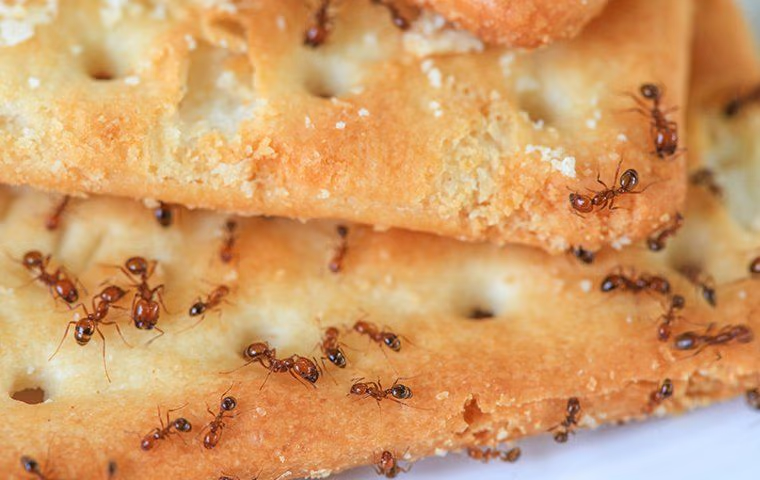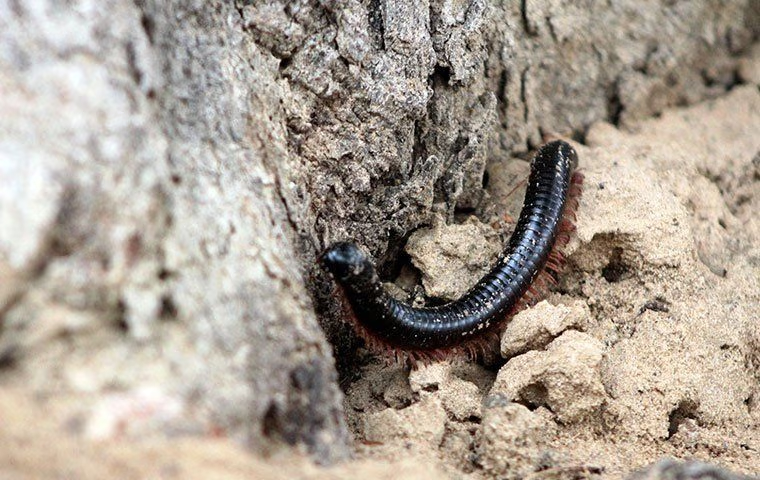White-footed ants are one of the most difficult ants to control in South Florida because they have multiple queens and incredibly large colonies that can reach up to three million members.
What do white-footed ants look like?
White-footed ants (WFA) are black with whitish tarsi (feet), and adults measure 1/8 inch long. The antennae have 12 segments with no club.
When the scouts find food, this species forms heavy single-file trails from the nest to the food. Along with the characteristic pale-yellow feet and distinctive trailing activity, it is easy to identify white-footed ants.
What are the signs of a white-footed infestation?
When WFAs forage on the exterior walls of homes, a solid trail of ants is observed. When inspecting for white-footed ants, it is important to look for branches touching the structure and utility cables that connect them to the home. Eventually, they find a small opening that leads to the interior of the house. Inside the walls, they follow electrical cables and emerge in various rooms.
What do white-footed ants eat?
White-footed ants are a sweet-feeding species and forage heavily for carbohydrates, but they also feed on dead insects and other proteins. In nature, WFAs feed on plant nectar and honeydew from aphids, mealybugs, and scales. Foragers are commonly found along branches of trees and shrubs collecting nectar and honeydew. Pheromone trails are laid by the foragers to recruit more workers resulting in heavy trailing activity.
How did I get white-footed ants?
White-footed ants prefer to nest outdoors in moist areas that provide protection from predators and the elements, such as in leaf litter, tree holes, mulch, rain gutters, and other debris.
When the population is large white-footed ants begin to infest Florida homes. Indoors they usually nest in wall voids and attics. Workers use branches touching the homes to cross over or small cracks around the foundation to sneak inside.
How were white-footed ants introduced to Florida?
White-footed ants were first detected in Homestead, Florida in the mid-1980s, and it is believed the ant was introduced accidentally from plants imported from Asia. Since Homestead is an agricultural area with many nurseries, the transportation of landscape plants has facilitated the distribution of WFAs throughout the state. Now it is a significant pest in South and Central Florida.
Why are white-footed ants hard to get rid of?
White-footed ants are hard to eliminate because they have a high reproductive potential and form super colonies in little time. The ability of white-footed ants to reproduce in large numbers is because half of the colony are reproductive females.
These fertile members are called “intercastes,” and are inseminated by wingless males. Swarms by winged reproductives occur annually between July and October in South Florida. After the nuptial flight, the inseminated queen flies to a potential nesting ground, sheds her wings, and starts to lay her fertilized eggs.
After the colony is formed, the founding queen is replaced by the reproductive workers. Another way WFAs expand is by a process called budding, in which the intercastes leave the old colony with other workers and brood to form a new nest.
How serious are white-footed ants?
Because WFAs colonies are so large, foragers often invade homes looking for food. This is another tramp species in South Florida and is frequently seen in kitchens, bathrooms, and the exterior of homes. White-footed ants do not bite or sting and do not cause structural damage, but they are known to short-circuit air conditioners.
White-footed ants lack some of the defensive capabilities common in many other ant species, such as venomous stings, soldiers with strong jaws, or the spray of toxic chemicals. The ability to reproduce in large numbers makes up for this deficiency.
How to get rid of white-footed ants?
For most ant species, the foragers make up 10% of the colony population; however, for white-footed ants, this is 50% of the population. Because a large number of sterile workers forage for food, the use of toxic baits is an effective method for killing at least half of the population.
In 1994, research from Japan stated that there is no trophallaxis in WFA and nutrient transfer among the colony is through trophic eggs (sterile eggs used for food). However, in 2003 a thesis by a graduate student from the University of Florida stated that trophallaxis had been observed on numerous occasions, and the feeding of trophic eggs has never been observed.
Whether there is no trophallaxis or some trophallaxis, since half of the population forage for food, we know that at least 50% of the population can be wiped out with just baits. By killing the foragers, the flow of nutrients will stop, and the non-foraging population will starve to death.
After several days of feeding, a very high percentage of mortality can be achieved with the right baits. Given that the population is so large, multiple application of fresh bait is required, and relying solely on bait is not an efficient method for achieving control of white-footed ants. Poor acceptance to the bait is another drawback of a baiting program.
Applying non-repellent insecticides along with a baiting program is the best way to control white-footed ants. Trimming branches and shrubs touching your home will eliminate potential highways that WFAs can use to gain access to your home. Sap-sucking insects produce honeydew, so they should be eliminated for lasting control of WFAs.
How to eliminate white-footed ants on my own?
When it comes to this species, it is best to call a South Florida pest control company. Dealing with white-footed ants is not like treating for sugar ants.
With ghost ants, homeowners can buy over-the-counter gel baits such as Terro and get some relief. WFAs are sweet ants, so this species is attracted to Terro; however, you will have to buy hundreds of stations and place them everywhere inside and outside the house. This will only put a little dent in the colony.
DIY treatments for white-footed ants do not work because you need a holistic approach to outpace their reproductive potential. When you hire an exterminator, you will probably save money by not buying useless products and getting faster control.
Why should I call an exterminator to control white-footed ants?
When you hire a highly-rated pest control company like GOTBUGSIKILL we will do a thorough inspection to ensure you are dealing with white-footed ants and find where they are nesting. We will also inspect the vegetation around your home to make sure there are no plant-sucking insects that produce honeydews.
Pest management professionals have access to non-repellent insecticides and special baits that will quickly eradicate the ants from your home. We encourage homeowners to sign up for our pest protection program, KILL365. With our quarterly services, we will keep the white-footed ants and other pests under control and stop them from re-infesting your home.
GOTBUGSIKILL is the best exterminator in Palm Beach, Broward, and Miami-Dade. If you are in our service area, give us a call today for a free quote and get started on our effective ant control services.

